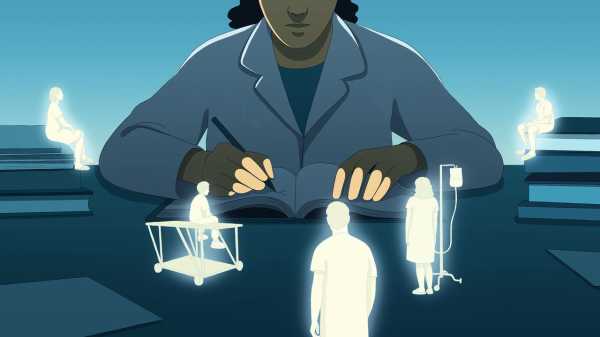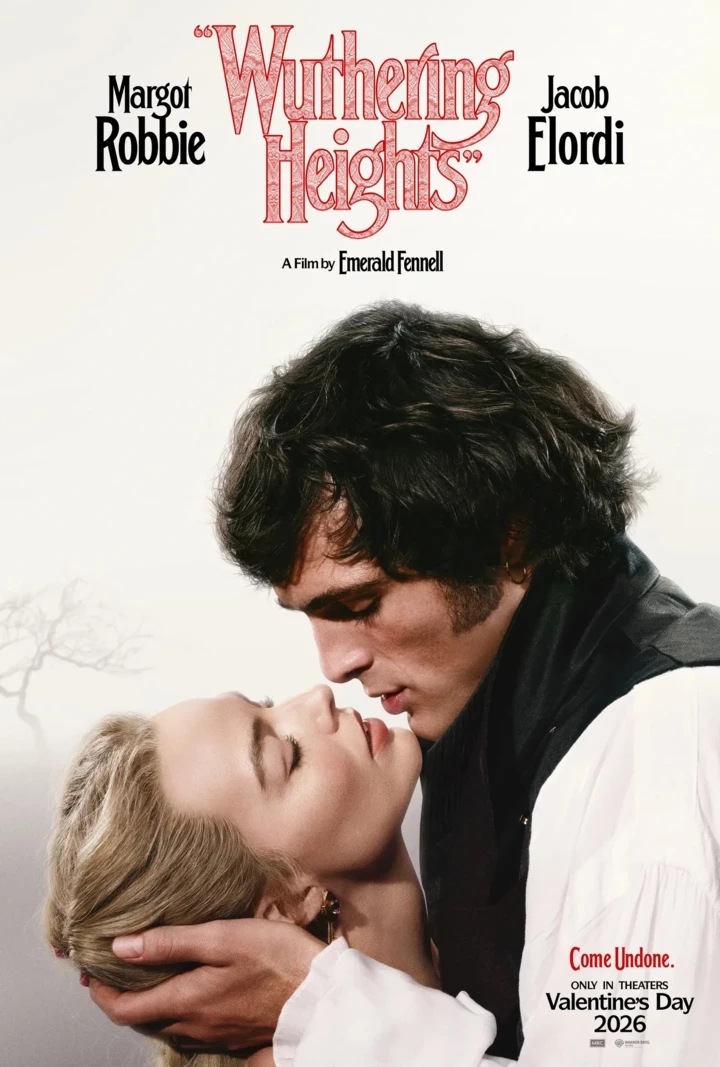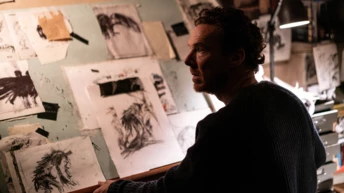
Save this storySave this storySave this storySave this story
The first patient I ever wrote about wasn’t actually my patient; as a first-year medical student, that possessive grammatical construct—“my patient”—hadn’t yet entered my consciousness, much less my lexicon. In any case, by the time I met him, he was already dead. I’d followed my fellow-students into the bowels of the medical examiner’s office, just north of Bellevue Hospital, past the silent storage areas of unclaimed bodies and into the clamor of the autopsy room. There he was—a boy, maybe twelve years old, claiming hardly any space on the metal table.
His jersey was pushed up to reveal a smooth preadolescent chest. His pristine basketball sneakers were oddly bright in a room that has since receded into shadow in my memory. I hardly registered the narrowness of the gap between our ages because I was blindsided by how small the bullet hole was. I didn’t have the language to articulate how something so tiny could carve such devastation.
A decade passed before I could write about that moment. By then, I’d finished medical school and residency, spending years in contiguity with such suffering that—against the advice of my academic mentors—I took off for eighteen months to temp as a travelling doctor, filling physician shortages in small towns and then wending through Central America to accrue some much-needed Spanish. In lonely strip malls and dusty markets, I began scribbling in notebooks. The boy on the metal table was the first ghost to come forward. I didn’t know then that I was slipping into a time-honored role, that of the doctor-writer. After all these years, though, I’m still trying to make a diagnosis: why is it that doctors write?
In one sense, doctors have always been writers, penning case reports since antiquity. Literary writing by doctors is a more modern development. Anton Chekhov and Oliver Wendell Holmes, Sr., were physicians, but their writing feels largely independent of their clinical day jobs; the term “doctor-writer” is generally reserved for the actively practicing physician whose writing stems directly from patient care. This model crystallized in the late twentieth century, with the neurologist Oliver Sacks and a pair of Yale surgeons, Sherwin B. Nuland and Richard Selzer. When I was a medical student, reading Sacks’s “The Man Who Mistook His Wife for a Hat” was revelatory. “Biologically, physiologically, we are not so different from each other,” Sacks wrote. “Historically, as narratives—we are each of us unique.” Medicine, he showed, could be an avenue into those narratives, and thus into that uniqueness.
There was no shortage of reading during med school, but it all felt strictly transactional—I memorized facts in order to ratchet forward in my training. Sacks, Nuland, and Selzer made me realize that there was someplace to go with all these facts. They wrote directly about medicine, dissecting the layered resonances of illness and the intricacies of being a doctor. Nothing could have prepared me better for my surgery rotation than Selzer’s explanation of how to use a scalpel, in his memoir, “Down from Troy”: “One holds the knife as one holds the bow of a cello,” he wrote. “The knife is not for pressing. It is for drawing across the field of skin.” In these writings, the doctor was a character in the story. Readers got to climb into the doctor’s shoes—an experience that could be uncomfortable, at times repugnant, but undeniably eye-opening.
These writers spawned a generation of doctor-writers. Today, it can seem as though every doctor leaves residency with the equivalent of a book bubbling inside. This is hardly surprising, as medical training catapults ordinary people into the extraordinary, where life-or-death stakes are no mere metaphors. If there’s a certain sameness to many medical memoirs—first baby delivered, first death, first resuscitation, first recognition that medicine cannot always cure—that doesn’t necessarily detract from readers’ fascination. Books by doctor-writers carry a special charge because of the true-life nature of the drama. But it’s not simply that, or at least it shouldn’t be—otherwise such writings border on exploitation. The nearest way I can describe it is a sense of awe, rekindled daily as we treat our patients, at the human condition and the ceaseless wrenching thereof. Where else can one grapple with something simultaneously so astonishing and so brutal, except on the page?
During my training, I devoured all the literary writing by doctors that I could get my hands on, desperate to understand “the anatomy and physiology of a hospital,” as pediatrician Perri Klass put it in her memoir, “A Not Entirely Benign Procedure.” The book—and her magazine columns that preceded it—offered me a crash course in the “grisly evidence of how thin the barrier is between normal life and disaster.” Abraham Verghese’s début, “My Own Country,” appeared during my residency, catching me in the Stygian pit that marks its midpoint. A bookish doctor raised by an Indian family in Ethiopia before training in internal medicine and infectious disease, Verghese touched down in a rural white Appalachian town just as H.I.V. was fracturing the community. Stereotypes, fears, and vulnerabilities piled up as patients—and the doctors caring for them—were buffeted by forces they could neither control nor predict. When Verghese described living “in a culture of disease, a small island in a sea of fear,” he articulated a dislocation that I hadn’t even realized I was experiencing, and one that was undoubtedly dwarfed by what my patients were living through.
When I bolted from my medical training, I had my own set of stories threatening to burst, though I don’t think I recognized them as stories per se. They were simply the contours of exhaustion. One of my first temp assignments was in a remote corner of New Mexico. In a modest community library, I stumbled across “The Blood of Strangers,” by an E.R. doctor named Frank Huyler. Most medical memoirs don’t make much of place—a hospital is a hospital is a hospital—but Huyler’s was set in the Southwest, with prose as angular and unadorned as the landscape outside my window. The stories were prose-poem length, whittled to the bone. Characters were bare outlines. Dispatched during a busy shift to pronounce a patient dead, Huyler pondered the randomness of life and death in the E.R. “Odds whisper around us, wheels turn, molecules whir like bobbins. And then, maybe once or twice in a whole life, events conspire, statistics align with the force of diamonds against us, and they knock us out, there is no chance, the wind blows through us, we’re gone.” The starkness of Huyler’s writing needles into an essential loneliness of medical practice. Despite all the wards, teams, departments, colleagues, it is so often just you and the patient—and the perilous stakes. I only understood this chilling solitude when I read Huyler.
“His erection startled me,” is the opening line of Rafael Campo’s essay collection “The Desire to Heal,” which I read as I was starting out as an attending physician. When Campo—a gay Latino man studying medicine at Harvard—found himself overwhelmed by stress, junk food, cigarettes, and zealous dieting, he ended up in a clinic office, both observing and fantasizing as the doctor examined him: “When he spoke, the pain ceased. . . . I could feel him listening to my heart and lungs, understanding all that which I had for so long found impossible to say.” The doctor “ran his hands over my body, extracting each gossamer toxin that was a shadow of my form, and dissolving it in a pool of sunlight,” Campo wrote. I realized that he was articulating what so many patients yearn for—a clean sweep of their ills from a physician who deeply understands their individual needs. (Campo’s nirvana is shattered, of course, by the reality of the actual medical evaluation, with its “punitive lubricated finger.”) One doesn’t often feel the pulse bounding off the page in doctors’ writings, but Campo’s book drove home the point that every character in the medical transaction—A.I. notwithstanding—is human, throbbing with impulses, often contradictory.
But what about the patients? What is their stake in this medical-literary enterprise, and what are they owed? Novelists may casually stitch family members into their books, but doctors have a fiduciary duty to their patients, not to mention an ethical one. A patient converges with a doctor in a singularly mortal moment, baring their wounds with the presumption of care and healing. There is an inherent asymmetry of vulnerability here; doctors and patients are not equals at the Thanksgiving table.
Within the medical profession, there are differing views about the ethics of doctor-writing. Some argue that a doctor must obtain formal consent from patients before writing about them, just as for any medical procedure; others think that the uniquely vulnerable position of a patient makes truly informed consent impossible. When I’ve asked patients if I can write about them, they’ve usually been amenable, often eager; many have spent years trying to get their story heard and welcome an opportunity to see it validated in the public record. There is still often a degree of unease, though, and most doctor-writers respond with various compromises: requesting written or oral consent, changing identifying characteristics, creating composite characters, using only broad outlines, waiting years, waiting until patients are deceased, shifting from nonfiction to fiction, or ditching narrative altogether and turning to poetry. Although there are few formal guidelines, a consensus has formed around consent when possible, de-identification when not, and adherence to the admonition that the patient’s welfare always comes first.
But it’s still a fair question: should doctors be writing about patients at all? Should protected information shared in confidence, in the setting of illness, with a high-stakes power differential, be fodder for writing—no matter how compelling? As far as I can tell, alas, no one has ever polled the patients, so we don’t know their opinion. (What we do know, for what it’s worth, is that readers—all of whom are, at some point, patients—seem to relish the books, and they keep coming.)
For quite a few years, including the one in which I entered medical school, every first-year medical student was handed an anthology, thanks to the Robert Wood Johnson Foundation, called “On Doctoring: Stories, Poems, Essays.” The contents ran the gamut from the Bible and Borges to Margaret Atwood and Ethan Canin. The book was meant to inspire us, but for many it gathered dust, pushed aside by more direly required reading like “Robbins Basic Pathology” and “Snell’s Clinical Anatomy.”
It may be hubris for an editor to include his own work in his version of the canon, but John Stone, the co-editor of “On Doctoring,” did just that. A poet and a cardiologist originally from Mississippi, Stone had delivered a commencement address, in verse, at Emory School of Medicine. The resulting poem, “Gaudeamus Igitur,” astonished me. Some random Southern doctor seemed to fully grasp my deepest fears. “For you will look smart and feel ignorant,” he wrote, “and the patient will not know which day it is for you.” In two brief pen strokes of poetry, Stone had summed up internship. A few lines earlier, he’d nailed the terror of holding someone’s fate in your hands: “For this is the day you know too little / against the day when you will know too much.”
Not long after I’d returned to Bellevue from my eighteen months sojourning, I picked up a brochure from a plastic yellow news box on Second Avenue, and enrolled in a writing workshop. It was my first exposure to writing as a craft, and I found that literary orderliness appealed to the same sense of just-rightness that biochemical pathways did. But I needed more than just tools, so I gathered up the gumption to write to Dr. Stone. He replied with a generous letter of encouragement, later signing my copy of the anthology over a memorable afternoon tea at Elephant & Castle, in Greenwich Village. When Stone died, in 2008, the lines of his poem immediately sprang to mind. “For this is the end of examinations,” he’d told those fledgling doctors. “For this is the beginning of testing.” And then he added the kicker: “For Death will give the final examination / and everyone will pass.”
Doctors, of course, write all day, every day—progress notes, consultations, assessments, referrals, appeal letters. This vast flow of ink is mostly dross, but it does have its distinctive style. We alight at a distance, with archly anonymous and studiously passive constructs. “A diastolic murmur was appreciated” is a classic M.D. line. You’d hardly know that an actual person stood there, palming a stethoscope over a human heart, tensing their ears to hear more clearly, categorizing the sounds, assessing sternal geography. We write at a remove, cordoning off our inner world behind a cool clinical eye and protective professional jargon.
Shedding that remove allows those inner worlds to come forward, however painfully. In her memoir “The Beauty in Breaking,” Michele Harper, an E.R. doctor, debrides her own wounds as assiduously as she does her patients’. She discovers, for example, that one of her young patients at the V.A. hospital was raped repeatedly while serving in Afghanistan, but never told anyone. “The girl I used to be had learned that lesson well in our little glass house in Washington, D.C.,” she writes. “Only in leaving that house did I come to know in my bones that the peril in being silenced was far greater than that of living loud enough to shatter those walls and bring the whole house down.” Working in urban E.R.s, Harper has no choice but to dwell in the unholy mixture of genes, geography, injustice, and random luck—the unedited first draft of illness. And she doesn’t have the luxury of being an armchair observer. “As a black woman, I navigate an American landscape that claims to be post-racial when every waking moment reveals the contrary,” she writes.
It’s not uncommon for medical memoirs to bleed into activism and advocacy. In “Facing the Unseen,” the psychiatrist Damon Tweedy asks why we insist on cleaving mental illness from physical illness. In “Treating Violence,” Rob Gore draws on his experiences as a community activist, an E.R. doctor, and a young Black man from Brooklyn to describe violence as a public-health issue. “When I was a younger physician, my patients and I were often the same age, same style, maybe even from the same area,” he writes. “The motif is common: a Black man losing his life while I am fighting to save it.” These books rattle with urgency; they need to be written. Stories offer a generosity of space—temporal, emotional, political—that real-time clinical work does not.
Some years back, I attended a lecture by Abraham Verghese about what doctors could learn from novelists. He described how novelists’ eye for nuance allows them to create character, voice, and metaphor; master diagnosticians, he noted, require a similar degree of subtlety in their observations. Narrative medicine, an increasingly popular scholarly field developed at Columbia University by the internist and literary scholar Rita Charon, aims to improve medical care by helping clinicians more fully understand their patients’ stories and perspectives. Reflective writing, another recent trend, is practically ubiquitous in medical schools and residency programs, and there is some evidence that writing may make doctors more empathetic and observant. Demonstrating that belletristic doctors actually make better endocrinologists or urologists, however, is more of a challenge. (To be fair, very little of our medical pedagogy has been rigorously linked to concrete clinical outcomes, but we do it anyway.)
In 2000, some colleagues and I came up with the idea of starting a literary publication at our hospital. We initially envisioned a photocopied and stapled affair to showcase the reflective writing of our medical students. In the end, Bellevue Literary Review débuted the following year as a full-scale literary journal. Twenty-five years on, it still receives thousands of submissions from the general public on the subjects of health and illness. I read these writings as an editor, but I often stumble onto insights that help me as a physician.
The very first issue of B.L.R. featured a short story by Denitza Blagev, who was then a medical student, about a cardiologist facing his impending death from cancer. “Because what if you don’t die?” the protagonist suddenly asks. “What if you spend weeks in the hospital, time you believed was your last among people, time during which everyone told you they loved you and would miss you? And then it turns out, months later, you are still here among the living . . . and no one has much to say to you, nor you to them.” This wasn’t a circumstance we’d ever been taught to think about in medical school, but, with the impressively effective H.I.V. treatments that had become widespread around that time, it was an everyday situation in the clinic. The story taught me to be attuned to this tension.
In the first month of my internship, in the sepulchral hours of the night, I was dispatched to an elderly patient whose hematocrit had plummeted, with orders to determine the source of the bleed. Night shift in a teeming academic hospital can feel like a relentlessly heaving freighter, and I’d been hustling from ward to ward bailing water; this task was just another on my scut list. I began my evaluation of the patient, my thoughts skittering through the “find-the-bleed” diagnostic algorithm I’d learned in medical school. And then, while I was doing my physical exam—head down, plugging through my intern duties—the patient died. Greenhorn that I was, I didn’t realize what had happened until a family member of the patient gently pointed it out to me.
In front of an audience of newly grieving relatives, running on caffeine fumes and rapidly disintegrating memories of every last fact I’d learned in medical school, I had to pronounce the patient dead, something that turned out to be far tougher than it looks on TV. I was hardly two weeks out of med school, and I needed to marshal enough maturity and wisdom to help a family cope with the loss of a matriarch. John Stone wasn’t kidding when he talked about the “beginning of testing.”
As with my earlier encounter with the boy in the autopsy room, it took years to come to terms with this experience. The pounding pace of medical training meant that, as soon as I’d finished handling the death of this patient, I raced off to the next crisis, and the next. I did that for the remaining hours of my shift, and the remaining years of my residency. Like everyone else clambering through the clinical gauntlet, I stuffed this intense experience into the back of my brain, stuffed the next one on top of it, and kept stuffing and stuffing, like a surgeon packing gauze into an open wound, until I came up for air somewhere near the age of thirty.
When I started writing, during that year and a half of travel after residency, it was the first time I attempted to unravel this tangle of stories. Narrating what happened with the boy in the autopsy room turned out to be wholly different from experiencing it; the riptide shock of that moment slowed to a largo of painful excavation. I could probe the might-have-beens of his short life and the what-remained of mine. I could stitch in the nightmares that trailed me for months and the afterimages that never faded. It was in the writing of the story that I felt the coaxing of connection, that the boy came to feel like “my patient.”
Revisions, the curse of many writers’ existence, turned out to be an epiphany for me. Going back again and again to that panicked night shift when the bleeding patient died under my hands was an unexpected salve for the unforgiving finality of the actual events. There was no bringing back the dead, of course; I couldn’t unpick my mistakes or erase the suffering of the patients and their families. But I could turn the experiences over with a tangibility that ordinary obsessing didn’t allow. Only later did I understand this as a grappling with unfathomable situations for which civilian life offered no template.
Yet processing our experience is merely part of why we write. When I teach newbie medical students the basics of the EKG, I ask them to imagine the heart surrounded by a circle of paparazzi; the twelve waveforms unspooling on the pink graph paper are the heart photographed from twelve different angles. Physicians, similarly, take pictures of our patients from multiple perspectives. We pull together these angles of vision—lab tests, X-rays, consultations—to see the multidimensional reality that is the patient and their illness. The goal of physicians who write might be to position the cameras just so—calibrating the lenses within our personal and clinical coördinates so that we can illuminate the experiences of medicine for the larger world of readers, most of whom have never, and will never, pronounce another human being dead.
The compulsion of doctors to write, then, may simply be an extension of the reason so many of us entered medicine—an implacable curiosity about how people tick. Doctoring provides powerful tools for getting under the hood, but writing offers ones that dig into the interstitial spaces where our more utilitarian tools falter. And this might reveal an even deeper aspect to writing—an element of purely being human. I never learned what had happened to the boy on the autopsy table. I never learned his name, his favorite basketball player, or whether he still relished hugs from his mother. I was not his doctor, yet he’s the patient who’s stayed with me the longest. Writing about him was perhaps the only way I had to care for him. ♦
Sourse: newyorker.com







